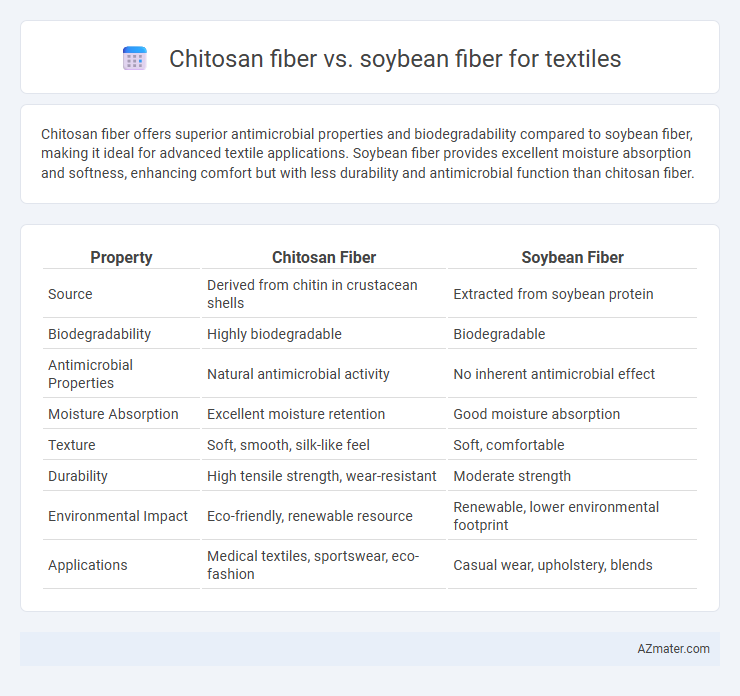Chitosan fiber offers superior antimicrobial properties and biodegradability compared to soybean fiber, making it ideal for advanced textile applications. Soybean fiber provides excellent moisture absorption and softness, enhancing comfort but with less durability and antimicrobial function than chitosan fiber.
Table of Comparison
| Property | Chitosan Fiber | Soybean Fiber |
|---|---|---|
| Source | Derived from chitin in crustacean shells | Extracted from soybean protein |
| Biodegradability | Highly biodegradable | Biodegradable |
| Antimicrobial Properties | Natural antimicrobial activity | No inherent antimicrobial effect |
| Moisture Absorption | Excellent moisture retention | Good moisture absorption |
| Texture | Soft, smooth, silk-like feel | Soft, comfortable |
| Durability | High tensile strength, wear-resistant | Moderate strength |
| Environmental Impact | Eco-friendly, renewable resource | Renewable, lower environmental footprint |
| Applications | Medical textiles, sportswear, eco-fashion | Casual wear, upholstery, blends |
Introduction to Chitosan and Soybean Fibers
Chitosan fiber is derived from chitin found in crustacean shells, valued for its biodegradability, antibacterial properties, and moisture absorption, making it ideal for advanced textile applications. Soybean fiber, extracted from soybean protein, offers eco-friendly benefits such as softness, breathability, and natural UV protection, widely used in sustainable fashion and home textiles. Both fibers contribute to green textile innovation by combining functionality with environmental responsibility.
Origin and Production Processes
Chitosan fiber originates from chitin, a natural polysaccharide extracted primarily from shellfish exoskeletons through deacetylation, making it biodegradable and antimicrobial, ideal for advanced textile applications. Soybean fiber is derived from soybean protein, produced by extracting protein from soybean meal and spinning it into fibers, offering a sustainable plant-based alternative with softness and moisture absorption. The production process of chitosan fiber involves chemical treatments to convert chitin to chitosan and fiber formation, whereas soybean fiber relies on protein solubilization and regeneration spinning techniques.
Fiber Structure and Chemical Composition
Chitosan fiber features a unique structure composed of b-(1-4)-linked D-glucosamine units derived from chitin, imparting strong biocompatibility and antimicrobial properties, while soybean fiber consists mainly of protein polymers rich in amino acids such as alanine, glycine, and serine, contributing to its excellent moisture absorption and elasticity. The chemical composition of chitosan fibers includes primary amine groups that enable functionalization and enhanced interaction with dyes and finishing agents, contrasting with the globular protein structure of soybean fibers that provides softness and biodegradability. These intrinsic differences in fiber morphology and chemistry influence their performance in textile applications, with chitosan fibers excelling in durability and bioactivity, and soybean fibers offering comfort and environmental sustainability.
Mechanical Properties Comparison
Chitosan fiber exhibits superior mechanical properties compared to soybean fiber, including higher tensile strength and better elasticity, making it more durable for textile applications. The molecular structure of chitosan provides enhanced fiber toughness and resistance to deformation, while soybean fiber tends to have lower tensile strength and elongation at break. These differences make chitosan fiber preferable for high-performance fabrics requiring durability and flexibility.
Comfort and Breathability
Chitosan fiber offers superior breathability and moisture-wicking properties, making it highly effective in maintaining skin dryness and comfort during wear. Soybean fiber provides excellent softness and elasticity, enhancing tactile comfort but may retain more moisture compared to chitosan fiber. The antimicrobial nature of chitosan further improves hygiene and odor control, contributing to enhanced overall comfort in textile applications.
Biodegradability and Environmental Impact
Chitosan fiber, derived from chitin in crustacean shells, exhibits superior biodegradability due to its natural enzymatic breakdown process, significantly reducing environmental pollution compared to synthetic fibers. Soybean fiber, a cellulose-based material extracted from soybean protein, also offers excellent biodegradability but involves more intensive agricultural inputs and water usage, impacting its overall ecological footprint. Evaluating lifecycle assessments, chitosan fiber presents a lower carbon footprint and less water consumption, making it a more sustainable choice in eco-friendly textile production.
Dyeability and Color Fastness
Chitosan fiber exhibits superior dyeability due to its abundant amino groups, which form strong ionic bonds with anionic dyes, resulting in vibrant and uniform coloration. Soybean fiber, while eco-friendly and soft, has lower dye affinity and often requires chemical modifications to achieve comparable dye uptake. Color fastness in chitosan fibers is generally higher, showing excellent resistance to washing and light exposure, whereas soybean fibers tend to fade more quickly under similar conditions.
Antimicrobial and Skin-Friendly Features
Chitosan fiber exhibits strong antimicrobial properties due to its natural ability to inhibit bacterial growth, making it highly effective in reducing odors and skin infections in textile applications. Soybean fiber offers excellent skin-friendly benefits with its smooth texture and high moisture absorption, promoting comfort and breathability for sensitive skin. The combination of chitosan's antimicrobial efficacy and soybean fiber's hypoallergenic qualities makes each fiber uniquely suited for health-conscious textile products.
Applications in Textile Industry
Chitosan fiber exhibits strong antimicrobial properties and excellent moisture management, making it ideal for sportswear, medical textiles, and hygienic clothing. Soybean fiber offers a soft texture and good moisture absorption, suitable for casual wear, lingerie, and eco-friendly fashion. Both fibers contribute to sustainable textile production by utilizing renewable resources and enhancing fabric comfort and functionality.
Market Trends and Future Prospects
Chitosan fiber and soybean fiber are gaining traction in the sustainable textile market due to their biodegradability and eco-friendly production processes, with chitosan offering antimicrobial properties that enhance textile functionality. The global market for chitosan fibers is projected to grow significantly, driven by demand in medical and sportswear applications, while soybean fiber benefits from its soft texture and moisture absorption, appealing to casual and luxury fashion segments. Innovations in bio-based textile manufacturing and increasing consumer awareness about environmental impact are expected to boost adoption of both fibers, with chitosan fibers poised for rapid expansion due to their added health benefits.

Infographic: Chitosan fiber vs Soybean fiber for Textile
 azmater.com
azmater.com